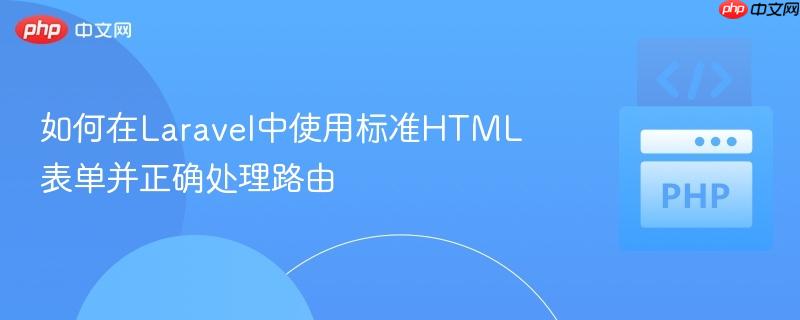
本文旨在指导用户如何在laravel应用中无缝集成标准html表单,并解决常见的`405 method not allowed`错误。我们将详细阐述表单`action`属性的正确配置,包括使用`route()`辅助函数指向控制器方法或命名路由,并强调`@csrf`令牌的重要性,确保表单数据能够安全、正确地提交到后端进行处理。
Laravel框架以其强大的功能和优雅的语法而闻名,但它也完全支持使用标准的HTML表单。对于前端开发者而言,这意味着可以继续使用熟悉的HTML结构来构建用户界面。然而,将这些表单与Laravel的后端逻辑正确连接,特别是处理路由和安全机制,是确保应用正常运行的关键。
当你在Laravel应用中提交表单时遇到 405 Method Not Allowed 错误,通常意味着以下两种情况之一:
这个错误提示清晰地表明,尽管你可能尝试向某个URL发送POST请求,但该URL仅支持GET、HEAD、PUT、PATCH、DELETE等方法,或者根本没有定义POST方法。
要在Laravel中正确使用标准HTML表单,你需要关注以下几个关键点:
立即学习“前端免费学习笔记(深入)”;
action属性定义了表单数据提交的目标URL。在Laravel中,我们通常使用route()辅助函数来动态生成这个URL,以确保其正确性和可维护性。
指向命名路由: 这是推荐的做法,因为它提供了更高的灵活性和可维护性。
// routes/web.php
Route::post('/posts', [App\Http\Controllers\PostController::class, 'store'])->name('posts.store');在表单中:
<form action="{{ route('posts.store') }}" method="POST">
<!-- 表单内容 -->
</form>直接指向控制器动作(不推荐作为action的直接参数,但了解其概念): 虽然action辅助函数可以直接指向控制器方法,但在表单的action中,通常还是通过命名路由来间接引用。直接使用action([Controller::class, 'method'])更常见于生成链接。
表单的method属性必须与后端路由定义中期望的HTTP方法一致。对于创建新资源的操作,通常使用POST方法。
<form action="{{ route('posts.store') }}" method="POST">
<!-- 表单内容 -->
</form>如果你需要模拟PUT、PATCH或DELETE请求(HTML表单原生只支持GET和POST),Laravel提供了一个@method指令:
<form action="{{ route('posts.update', $post->id) }}" method="POST">
@method('PUT')
<!-- 表单内容 -->
</form>Laravel默认开启了CSRF(跨站请求伪造)保护。对于所有POST、PUT、PATCH和DELETE请求,你必须在表单中包含一个CSRF令牌,否则会收到419 PAGE EXPIRED错误。Laravel通过@csrf Blade指令简化了这一过程。
<form action="{{ route('posts.store') }}" method="POST">
@csrf
<!-- 表单内容 -->
</form>@csrf指令会生成一个隐藏的输入字段,其中包含一个唯一的令牌,Laravel会在请求到达时自动验证此令牌。
下面是一个将前端HTML表单、后端控制器和路由定义连接起来的完整示例。
<!DOCTYPE html>
<html lang="en">
<head>
<meta charset="UTF-8">
<meta name="viewport" content="width=device-width, initial-scale=1.0">
<title>创建新文章</title>
<link href="https://stackpath.bootstrapcdn.com/bootstrap/4.5.2/css/bootstrap.min.css" rel="stylesheet">
</head>
<body>
<div class="container mt-5">
<h1>创建新文章</h1>
<form action="{{ route('posts.store') }}" method="POST">
@csrf
<div class="form-group">
<label for="title">标题</label>
<input type="text" class="form-control" id="title" name="title" required>
</div>
<div class="form-group">
<label for="body">内容</label>
<textarea class="form-control" id="body" name="body" rows="5" required></textarea>
</div>
<button type="submit" class="btn btn-primary">提交</button>
</form>
</div>
</body>
</html>注意: 原始问题中的input class="form-control" rows="5" id="comment"> </input>应改为<textarea>标签,因为rows属性是用于多行文本输入框的。
<?php
namespace App\Http\Controllers;
use Illuminate\Http\Request;
class PostController extends Controller
{
/**
* 显示创建新文章的表单。
*
* @return \Illuminate\View\View
*/
public function create()
{
return view('posts.create');
}
/**
* 存储新创建的文章。
*
* @param \Illuminate\Http\Request $request
* @return \Illuminate\Http\RedirectResponse
*/
public function store(Request $request)
{
// 验证请求数据
$request->validate([
'title' => 'required|max:255',
'body' => 'required',
]);
// 这里可以执行保存文章到数据库的逻辑
// 例如:
// Post::create([
// 'title' => $request->title,
// 'body' => $request->body,
// ]);
// 模拟保存成功并重定向
return redirect()->route('posts.index')->with('success', '文章创建成功!');
}
/**
* 显示所有文章的列表。
* (为了示例完整性,假定存在一个列表页)
*
* @return \Illuminate\View\View
*/
public function index()
{
// 实际应用中会从数据库获取文章列表
$posts = [
(object)['id' => 1, 'title' => '我的第一篇文章', 'body' => '这是文章内容。'],
(object)['id' => 2, 'title' => 'Laravel学习笔记', 'body' => '学习Laravel很有趣。'],
];
return view('posts.index', compact('posts'));
}
}<?php
use Illuminate\Support\Facades\Route;
use App\Http\Controllers\PostController;
/*
|--------------------------------------------------------------------------
| Web Routes
|--------------------------------------------------------------------------
|
| Here is where you can register web routes for your application. These
| routes are loaded by the RouteServiceProvider within a group which
| contains the "web" middleware group. Now create something great!
|
*/
Route::get('/', function () {
return view('welcome');
});
// 显示创建文章的表单
Route::get('/posts/create', [PostController::class, 'create'])->name('posts.create');
// 处理表单提交,存储新文章
Route::post('/posts', [PostController::class, 'store'])->name('posts.store');
// (可选) 显示文章列表的路由,用于重定向后展示
Route::get('/posts', [PostController::class, 'index'])->name('posts.index');通过以上配置,当用户访问/posts/create时,会看到创建文章的表单。填写并提交表单后,数据会通过POST请求发送到/posts路由,并由PostController的store方法处理。
在Laravel中使用标准HTML表单不仅可行,而且非常直接。关键在于正确配置表单的action属性以指向正确的Laravel路由,确保method属性与路由定义匹配,并包含必要的@csrf令牌。通过理解这些核心概念并遵循最佳实践,你可以轻松地将任何HTML表单集成到你的Laravel应用中,并构建出健壮且安全的Web应用。
以上就是如何在Laravel中使用标准HTML表单并正确处理路由的详细内容,更多请关注php中文网其它相关文章!

Copyright 2014-2025 https://www.php.cn/ All Rights Reserved | php.cn | 湘ICP备2023035733号